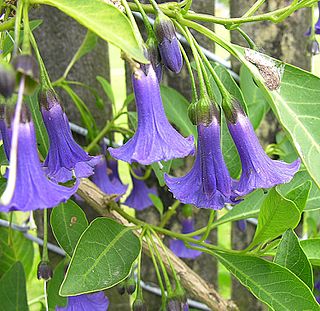
Iochroma is a genus of about 34 species of shrubs and small trees belonging to the nightshade family Solanaceae. Species are native from Mexico to south Brazil. They are found in the forests of Mexico and South America. Their hummingbird-pollinated flowers are tubular or trumpet-shaped, and may be blue, purple, red, yellow, or white, becoming pulpy berries. The cupular (cup-shaped) calyx is inflated in some species. The leaves are alternate, simple, and entire.
Parodiodendron is a monotypic plant genus under the family Picrodendraceae, described as a genus in 1969. The sole species is Parodiodendron marginivillosum(Speg.) Hunz..
Timothy Charles Plowman was an American ethnobotanist best known for his intensive work over the course of 15 years on the genus Erythroxylum in general, and the cultivated coca species in particular. He collected more than 700 specimens from South America, housed in the collection of the Field Museum of Natural History. The standard author abbreviation Plowman is used to indicate this person as the author when citing a botanical name.

Hieronymiella is a genus of flowering plants in the Amaryllis family. It is native to Bolivia and north-western Argentina.

Balbisia is a genus of flowering plants belonging to the family Francoaceae. It is also in the Vivianiaceae subfamily.

The Solanaceae, or the nightshades, are a family of flowering plants that ranges from annual and perennial herbs to vines, lianas, epiphytes, shrubs, and trees, and includes a number of agricultural crops, medicinal plants, spices, weeds, and ornamentals. Many members of the family contain potent alkaloids, and some are highly toxic, but many—including tomatoes, potatoes, eggplant, bell, and chili peppers—are used as food. The family belongs to the order Solanales, in the asterid group and class Magnoliopsida (dicotyledons). The Solanaceae consists of about 98 genera and some 2,700 species, with a great diversity of habitats, morphology and ecology.

Eriolarynx is a genus of flowering plants in the family Solanaceae, found in Peru, Bolivia and northern Argentina. Their trumpet-shaped flowers are pollinated by hummingbirds, and to a lesser extent, bees.
Trozelia is a genus of flowering plants belonging to the family Solanaceae. It is also within the Physalinae (Miers) Hunz. subtribe.
Darcyanthus is a monotypic genus of flowering plants belonging to the family Solanaceae. The single known species is Darcyanthus spruceanus(Hunz.) Hunz. ex N.A.Harriman
Deprea is a genus of flowering plants belonging to the family Solanaceae.
Neomortonia is a monotypic genus of flowering plants belonging to the family Gesneriaceae. It just contains one species, Neomortonia roseaWiehler
Saracha is a genus of flowering plants belonging to tribe Physaleae of subfamily Solanoideae of the nightshade family Solanaceae. The genera most closely related to Saracha are Iochroma, Dunalia, and Vassobia.
Schultesianthus is a genus of flowering plants belonging to the family Solanaceae.
Henoonia is a monotypic genus of flowering plants belonging to the family Solanaceae. The only species is Henoonia myrtifolia. It is native to Cuba.
Hunzikeria is a genus of flowering plants belonging to the family Solanaceae.

Metternichia is a genus of flowering plants belonging to the family Solanaceae. For a long time he only species was Metternichia principisJ.C.Mikan., but recently a second species, M. macrocalyx (Carvalho)L.S.de Souza was recognised
Nectouxia is a monotypic genus of flowering plants belonging to the family Solanaceae. The only species is Nectouxia formosa. It is in the Solanoideae subfamily and in Subtribe Salpichroinae, which is a subtribe of Physaleae.
Plowmania is a monotypic genus of flowering plants belonging to the family Solanaceae. The only species is Plowmania nyctaginoides.
Poortmannia is a genus of flowering plants belonging to the family Solanaceae. It is also in Solanoideae subfamily, tribe Solandreae Miers and also subtribe Juanulloinae. The genus has only one known species, Poortmannia speciosaDrake.
Doselia is a genus of hemiepiphytic lianas belonging to the Solandreae tribe of the nightshade family, Solanaceae. The species belonging to this genus are endemic to the premontane forests of the Colombian and Ecuadorian Andes.





